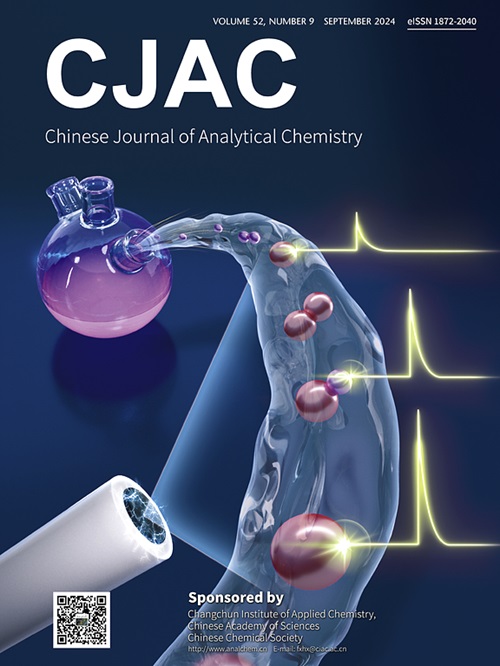新型偶氮染料金属离子配合物的合成、表征、抗氧化和生物活性评价及热力学分析
IF 1.3
4区 化学
Q4 CHEMISTRY, ANALYTICAL
引用次数: 0
摘要
本研究利用新型偶氮染料5,5-[1,2-苯双(2,1-双氮二基)][8-喹啉酸]与Co2+、Ni2+、Cu2+、Zn2+和Cd2+离子合成配合物。采用1H和13C核磁共振(NMR)、傅里叶变换红外(FT-IR)光谱、紫外可见(UV-Vis)光谱、质谱、热重分析(TGA)、差示扫描量热分析(DSC)、CHN分析对化合物进行了表征。此外,利用傅里叶变换红外光谱对配体的电导率、磁化率、金属和氯含量进行了分析,发现配体螯合成双齿(OH)酚基和双齿(CN)环基。配体表现出四齿行为,形成四面体配合物。除Co和Ni配合物为八面体外,其余均为非电解质。具有不同八面体部分的空气稳定配合物以2:1的金属:配体摩尔比生成。以2,2-二苯基-1-苦酰肼(DPPH)为自由基,没食子酸为标准物质,通过抗氧化剂的作用来评价这两种化合物对自由基的抑制作用。IC50值表明该配体具有较高的自由基抑制能力,且对化合物的抑制能力存在差异。在不同浓度下,对Co2+、Cu2+和Zn2+配体和配合物对大肠杆菌、芽孢杆菌、青霉菌、黑曲霉、镰刀菌和木霉的抑菌效果进行了测试,与对照相比,对细菌和真菌的生长有不同的抑制效果。本文章由计算机程序翻译,如有差异,请以英文原文为准。

Synthesis, characterization, antioxidant and bioactivity assessment, and thermodynamic analysis of metal ion complexes using a novel azo dye
In this study, the new azo dye,5,5-[1,2-phenylenebis(2,1-biazenediyl)] bis[8-quinolino], was used to synthesize complexes with Co2+, Ni2+, Cu2+, Zn2+, and Cd2+ ions. The compounds were characterized using 1H and 13C nuclear magnetic resonance (NMR) spectroscopy, Fourier transform infrared (FT-IR) spectroscopy, ultraviolet-visible (UV-Vis) spectroscopy, mass spectrometry, thermo gravimetric analysis (TGA), diffevential scanning calovimltry (DSC), CHN analysis. Further, conductivity, magnetic susceptibility, and metal and chlorine content analysis using FT-IR spectroscopy revealed that the ligand chelates as a bidentate (OH) phenol group and a bidentate (C![]() N) ring group. The ligand exhibited tetradentate behavior, forming tetrahedral complexes. Except for Co and Ni complexes,whichare octahedral, all of them are non-electrolytes. Air-stable complexes with distinct octahedral moieties were created in a 2:1 metal:ligand molar ratio. The effectiveness of both the compounds in inhibiting free radicals was evaluatedbased on their ability to act as antioxidants was assessed using 2,2-diphenyl-1-picrylhydrazyl (DPPH) as a free radical and gallic acid as a standard substance. The IC50 value indicated that the ligand had higher free radical inhibition ability, and the ability to inhibit the compoundsvaried.The ligand and complexes with Co2+, Cu2+, and Zn2+ were tested against Escherichia coli, Bacillus spp, Penicillium, Aspergillus niger, Fusarium, and Trichoderma at two concentrations, showing varying inhibitory effects on bacterial and fungal growth compared to the control.
N) ring group. The ligand exhibited tetradentate behavior, forming tetrahedral complexes. Except for Co and Ni complexes,whichare octahedral, all of them are non-electrolytes. Air-stable complexes with distinct octahedral moieties were created in a 2:1 metal:ligand molar ratio. The effectiveness of both the compounds in inhibiting free radicals was evaluatedbased on their ability to act as antioxidants was assessed using 2,2-diphenyl-1-picrylhydrazyl (DPPH) as a free radical and gallic acid as a standard substance. The IC50 value indicated that the ligand had higher free radical inhibition ability, and the ability to inhibit the compoundsvaried.The ligand and complexes with Co2+, Cu2+, and Zn2+ were tested against Escherichia coli, Bacillus spp, Penicillium, Aspergillus niger, Fusarium, and Trichoderma at two concentrations, showing varying inhibitory effects on bacterial and fungal growth compared to the control.
求助全文
通过发布文献求助,成功后即可免费获取论文全文。
去求助
来源期刊
CiteScore
3.60
自引率
25.00%
发文量
17223
审稿时长
35 days
期刊介绍:
Chinese Journal of Analytical Chemistry(CJAC) is an academic journal of analytical chemistry established in 1972 and sponsored by the Chinese Chemical Society and Changchun Institute of Applied Chemistry, Chinese Academy of Sciences. Its objectives are to report the original scientific research achievements and review the recent development of analytical chemistry in all areas. The journal sets up 5 columns including Research Papers, Research Notes, Experimental Technique and Instrument, Review and Progress and Summary Accounts. The journal published monthly in Chinese language. A detailed abstract, keywords and the titles of figures and tables are provided in English, except column of Summary Accounts. Prof. Wang Erkang, an outstanding analytical chemist, academician of Chinese Academy of Sciences & Third World Academy of Sciences, holds the post of the Editor-in-chief.

 求助内容:
求助内容: 应助结果提醒方式:
应助结果提醒方式:


